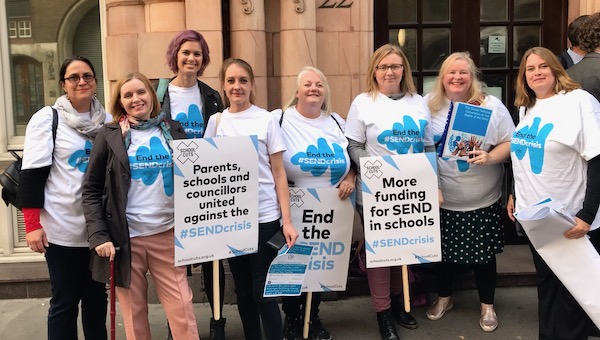https://specialneedsjungle.com/united-voices-making-a-stand-for-our-send-children/

Where Now for Inclusive Education
Where now for Inclusive Education?
Richard Rieser, World of Inclusion rlrieser@gmail.com
Progress towards a more equitable society where all can exercise their human rights, is often not straight forward. Powerful vested interests can subtly draw parents into their web, so confusing them about what is in their or their children’s best interests.
Progress towards inclusive education for disabled children and those with special educational needs is a case in point. The current coalition Government says it is committed ‘to removing the bias to inclusive education in our English Education system’ and supports more parental choice while introducing real term cuts across all schools and seeking to break up a thirty year consensus of moving towards more inclusive approaches. At the same time under the smokescreen of ‘choice’ parents and special schools are being urged/bribed to opt-out of Local Authority support and planning to set up Special Academies and special Free Schools.
Under the last Government, after a wide consultation with parents and educationalists, the Lamb Inquiry identified 60 improvements that could be made to the education system for disabled children and those with SEN. Many of these have been ignored by the present Government, choosing instead to thrust the education of disabled children into the front line in their ideological battle to break up state education and prepare the way for much greater private sector involvement.
In the Green Paper ‘Support and Aspiration’, they hold out a panacea of ‘parental choice’, ‘new special school academies’, ‘special free schools’, removal of bureaucracy and the streamlining of the process of assessing needs and providing support, by providing a single assessment of disabled young people aged 0-25, for Education, Health and Care Plans. It can sound seductive to parents who have been fighting to get their disabled children a decent education.
Even Local Authorities that were exemplary in meeting the needs of disabled children are being forced to weaken their services by centrally imposed cuts.The National Deaf Children’s Society recently reported thayt 40% of Las in England have cut the number of specialist Teachers of the Deaf. In attempts not to cut class teachers massive cuts programmes have been announced across Children’s Services in nearly every Local Authority over the next four years. For example Barnet, Lambeth, City of Leicester Educational Psychologists are being cut, in Haringey Speech and Language Therapists and Youth Workers across the country. Educational Welfare is a favourite target, as are Behaviour support teams such as in Tower Hamlets and Camden. All this can only be viewed as a cynical exercise to destabilise the provision for SEN and disabled pupils, to open it up to privatisation.
Yet the vast majority of parents of children with statements of SEN, those on School Action and School Action Plus are happy with the provision made for their children. There are currently 1.7 million children in the SEN system and all but 6% are in mainstream schools. There is not a huge rush to the SENDIST to get children placed in special schools. There are 254,000 children with a statement of SEN and 41% attend special schools. In 2009-2010 there were 1408 appeals to SENDIST, which involved where the child went to school, with 443 of these conceded to the parents. This hardly evidence of widespread dissatisfaction with the SEN system, as claimed by the Government.
It is true that a minority of parents, particularly of children on the autistic continuum, are unhappy with the treatment their disabled children receive at school. According to the Council for Disabled Children many who have opted for special school claim to be refugees from the mainstream system where their child was bullied or their needs were not met.
Since 2002 all schools have been under a legal duty to eradicate disability related harassment against disabled pupils, and yet according to the Equality and Human Rights Commission Triennial Review-How Equal is Britain (2010) , 80% say they have experienced bullying at school. Since 2002, all schools have been under a legal duty to make reasonable adjustments for disabled pupils in admission, education and associated services and exclusion. Yet exclusion of disabled pupils are 9 times higher than non-disabled pupils and 20 times higher for those on School Action Plus. This is clear evidence of a lack of training and whole school provision to accommodate disabled pupils. Despite rhetoric and policies from the last Government about inclusion, over the last 13 years there were more children in separate segregated settings because of their SEN or impairment than when they came to power.
There were of course many schools where there was an inclusive ethos , positive attitudes and good inclusive practice-around 20% according to OFSTED (2004). A larger number of mainstream schools around 60% were adequate but with much room for improvement. 20% were not implementing inclusive practice. Much of this poor practice results from the old deficit model, as viewing the problem within the child and their impairment-medical model thinking. The good practice is in schools which are prepared to change and adapt policies, practices and curricula, to accommodate different styles and types of learning and assessment. Such schools also have a leadership whose ethos is informed by equalities and inclusion, where staff are supported in resources, staffing and training disability equality from a social model. Interestingly, neither the Education Bill nor the Green Paper address this success of inclusive education or analyses how to make it more widespread and effective, in line with international treaty requirements, such as Article 24 of the UN Convention on the Rights of People with Disabilities. In addition, the Green Paper says the Government will make it more difficult for parents to choose a mainstream school for their disabled children, bringing back caveats to Section 316 of the 1996 Education Act, which were dropped in the 2001 Act. Therefore, the cost of mainstream education and the appropriateness will be reintroduced, bringing back the position of ‘compulsory segregation’ against the wishes of parent and child that existed before 2002. This fits in with the new harsh approach to exclusion with no appeal, which will lead to an increase in the exclusion of disabled pupils. Already there is much evidence of a disproportionate number of disabled pupils being excluded from Academies.
Teachers need more training on how to run inclusive classrooms. Nearly every class has disabled children. The Government are suggesting that the expertise of special schools is key to developing training for mainstream colleagues on how to include disabled children. This is to misunderstand the specialist expertise of special school colleagues, which by its very nature does not fit into the mainstream setting.
The gains made in the development of inclusive education are now under threat by Government. However, good inclusive practice was always initiated and led by teachers and head teachers, seeking greater equality for disabled pupils and students. It will be harder in the coming months and years, but we are engaged in a struggle for the heart and soul of not only our education system but our society. We will need to keep inclusion as one of our goals for a good local school for every child in every area, rather than the inequality of choice and privatisation.

